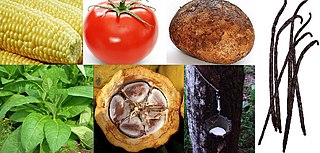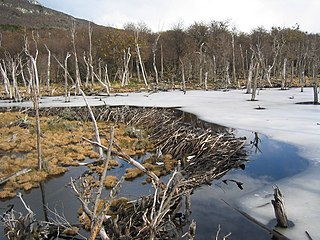 W
WAdventive plants or adventitious plants are plants that have established themselves in a place that does not correspond to their area of origin due to anthropogenic influence and, therefore, are all wild species that have only been established with the help of humans, in contrast to the native species.
 W
WBiological pollution is the impact of humanity's actions on the quality of aquatic and terrestrial environment. Specifically, biological pollution is the introduction of non-indigenous and invasive species. When the biological pollution is introduced to an aquatic environment, it contributes to water pollution.
 W
WAnthropocentric climate change has been found to bring about the increase in temperature and precipitation in a range of ecosystems. The drastic change of these climate factors is predicted to progress leading to the destabilization of ecosystems. Human-caused climate change and the rise in invasive species are directly linked through changing of ecosystems. The destabilization of climate factors in these ecosystems can lead to the creation of a more hospitable habitat for invasive species- species that not historically found in the impacted regions. Thus, invasive species are able to spread beyond their original boundaries. This relationship is notable because climate change and invasive species are also considered by the USDA to be two of the top four causes of global biodiversity loss.
 W
WThe Columbian exchange, also known as the Columbian interchange, was the widespread transfer of plants, animals, precious metals, commodities, culture, human populations, technology, diseases, and ideas between the New World in the Western Hemisphere, and the Old World (Afro-Eurasia) in the Eastern Hemisphere, in the late 15th and following centuries. It is named after the Italian explorer Christopher Columbus and is related to the European colonization and global trade following his 1492 voyage. Some of the exchanges were purposeful; some were accidental or unintended. Communicable diseases of Old World origin resulted in an 80 to 95 percent reduction in the number of Indigenous peoples of the Americas from the 15th century onwards, most severely in the Caribbean. The cultures of both hemispheres were significantly impacted by the migration of people from the Old World to the New. African slaves and European colonists replaced the Indigenous populations across the Americas. The number of Africans coming to the New World was far greater than the number of Europeans coming to the New World in the first three centuries after Columbus.
 W
WAn ecosystem engineer is any species that creates, significantly modifies, maintains or destroys a habitat. These organisms can have a large impact on species richness and landscape-level heterogeneity of an area. As a result, ecosystem engineers are important for maintaining the health and stability of the environment they are living in. Since all organisms impact the environment they live in in one way or another, it has been proposed that the term "ecosystem engineers" be used only for keystone species whose behavior very strongly affects other organisms.
 W
WEscaped plants are cultivated plants, usually garden plants, that are not originally native to an area, and due to their dispersal strategies, have escaped from cultivation and have settled in the wild and bred there, whether intentionally or unintentionally. Escaped plants are purposefully introduced plants that have naturalized in the wild and can develop into invasive plants, the settlement of which is to be assessed as problematic. Other commonly used terms include escaped garden plant, garden escapee, escaped ornamental or garden refugee.
 W
WHemerochory is the distribution of cultivated plants or their seeds and cuttings, consciously or unconsciously, by humans into an area that they could not colonize through their natural mechanisms of spread, but are able to maintain themselves without specific human help in their new habitat.
 W
WAlien species, or species that are not native, invade habitats and alter ecosystems around the world. Invasive species are only considered invasive if they are able to survive and sustain themselves in their new environment. A habitat and the environment around it has natural flaws that make them vulnerable to invasive species. The level of vulnerability a habitat is to invasions from outside species is defined as its invasibility. One must be careful not to get this confused with invasiveness, which relates to the species itself and its ability to invade an ecosystem.
 W
WAn invasive species is an introduced organism that becomes overpopulated and negatively alters its new environment. Although their spread can have beneficial aspects, invasive species adversely affect the invaded habitats and bioregions, causing ecological, environmental, and/or economic damage. Sometimes the term is used for native species that become invasive within certain ecosystems due to human alterations of the environment. An example of a native invasive species is the purple sea urchin which has decimated natural kelp forests along the northern California coast due to the historic overhunting of its natural predator, the California sea otter. In the 21st century, invasive species have become a serious economic, social, and environmental threat.
 W
WThere are a number of Australian species that have become invasive when introduced into outside Australia or outside Oceania.
 W
WKappaphycus alvarezii, the elkhorn sea moss, is a species of red algae. It is one of the most important commercial sources of carrageenans, a family of gel-forming, viscosifying polysaccharides. Farming methods affect the character of the carrageenan that can be extracted from the seaweed.
 W
WThe North Texas Invasive Species Barrier Act of 2014 is a bill that would exempt the North Texas Municipal Water District (NTMWD) from prosecution under the Lacey Act for transferring water containing invasive species from Oklahoma to Texas. The Lacey Act protects plants and wildlife by creating civil and criminal penalties for various violations, including transferring invasive species across state borders. The exemption would allow water transfers to go ahead and happen.
 W
WPlectranthus ecklonii is a shrub from the mint family Lamiaceae, native to South Africa. The habitat includes forest or shaded situations near the coast.